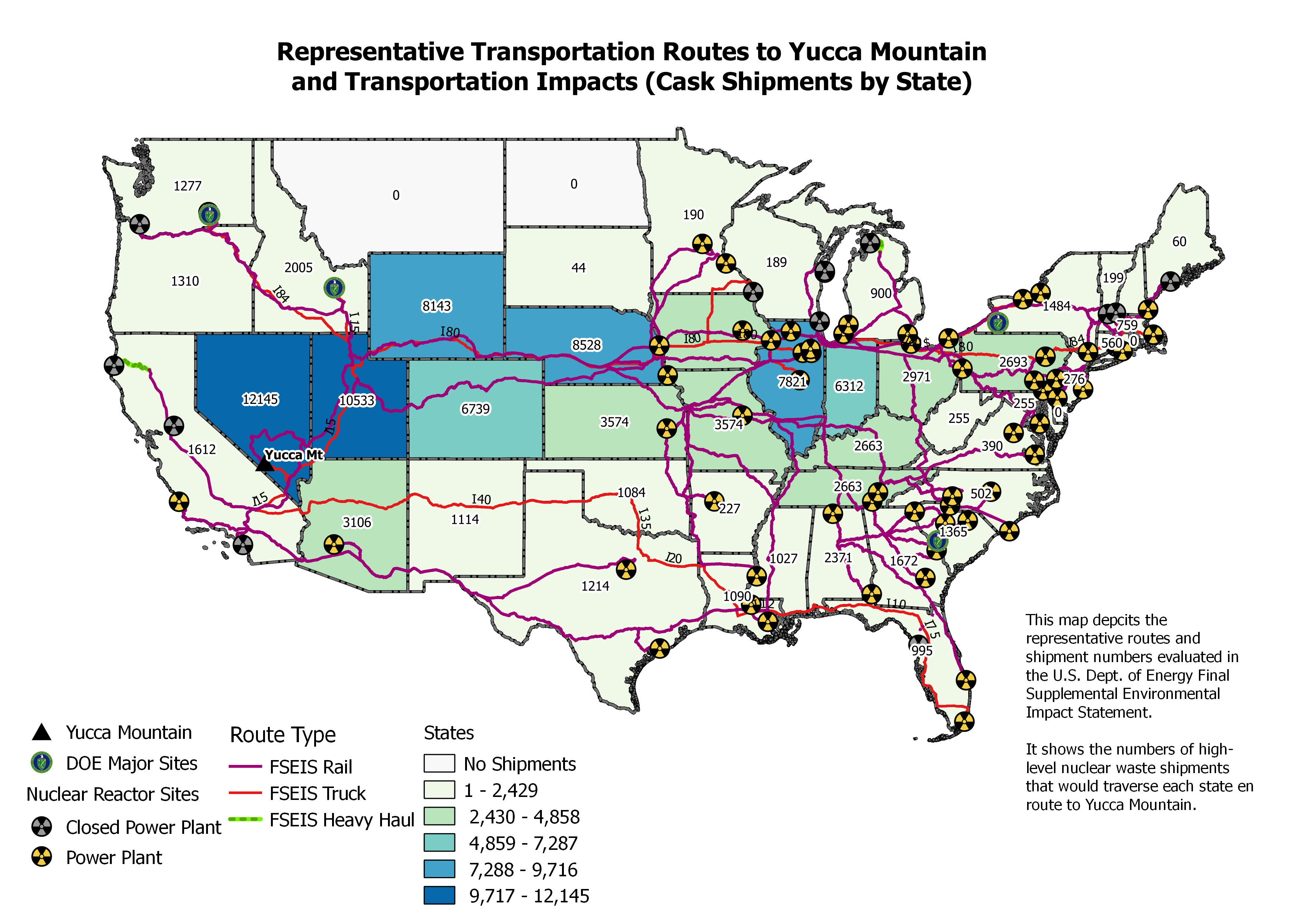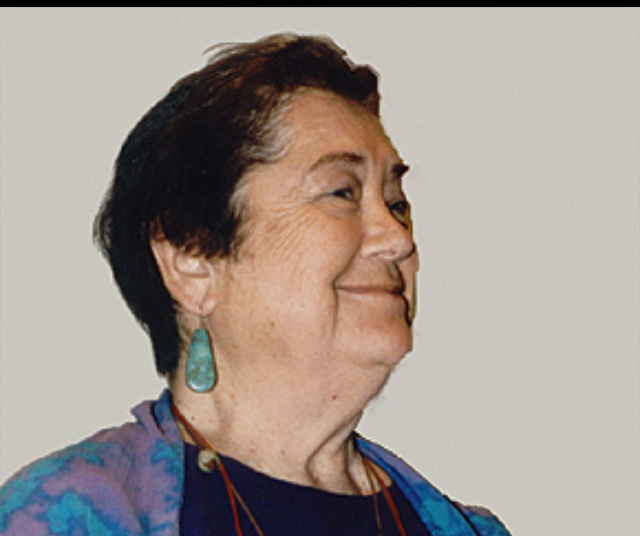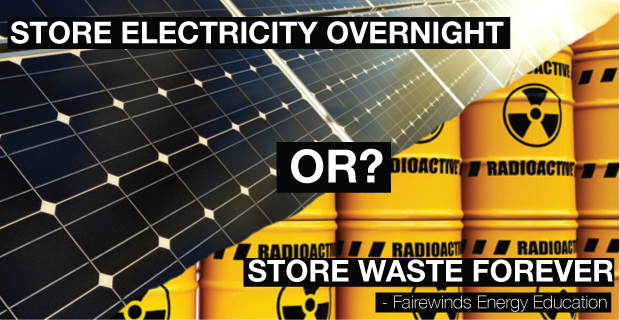
The Department of Energy (DOE) has a new generation of leadership; “larger than life” John Kotek is promoting nuclear energy via selling a “durable solution” to the problem of deadly radioactive waste that is the direct result of generating electric power from the heat of fission. Without a perceived solution to handling this existential problem, promotion of more nuclear energy usually falls on deaf ears. After all, wastes that will be a hazard to all life on Earth over the next million years, even when contained, do pose a threat. And the DOE’s track record on radioactive waste, exemplified by the failed Yucca Mountain project, hardly inspires confidence.
So Kotek has a new plan: volunteers. He wants states and communities to “consent” to storing nuclear waste in their jurisdictions. His process? Hold a bunch of meetings to put out the “welcome mat,” and work to get Congress to gut the existing Nuclear Waste Policy Act, greasing the skids for two locations where nuclear corporations are volunteering rural areas of New Mexico and Texas for new waste sites.
I went to Atlanta on Monday, April 11, to participate in one of these public meetings, the third in a series of nine that the DOE is hosting across the U.S. Next up is Sacramento this month, on Chernobyl Day (April 26) in fact. That will be followed by Denver, Boston, Tempe, Boise, and Minneapolis–about every two weeks until the end of July. Go here for dates, times and locations as well as registration information.
The Atlanta meeting was surreal. Half the room were career nuclear waste professionals, including myself…we all recognize each other and can pretty much predict exactly what each will say…who needs a meeting? Nearly a third of the room is paid meeting staff—many crossovers from the DOE’s two-year “Blue Ribbon Commission on America’s Nuclear Future” (or “BRC”) now sporting consulting firm names like “North Wind.” Long-time NRC facilitator Chip Cameron is on the team.
Georgia Governor Perdue opened the session asking us to “solve the waste problem now, and don’t leave it to our grandchildren.” I wanted to yell it was too late for that, since no matter what this was is going to be around for thousands of generations to come! He was followed by Kotek since the video of Secretary of Energy Moniz malfunctioned. Then a four-person panel gave short viewpoints. Mindy Goldstein, from the Turner Law Clinic did a great job, talking fast to get in as many points as possible. She was bracketed by a man named Bubba with the Public Service Commission of Georgia, Rick McLeod, top advocate for everything nuclear over at the Savannah River Site (DOE nuclear-bomb production site), and a social-science professor who seems to believe that DOE is acting in good faith. He assumes that the Department actually intends to launch a full-scale community-based negotiated “consent” process. Later, this professor is in the same small discussion group with me. I am not sure, I but I think when it dawned on him that DOE was using this very meeting in Atlanta as its “public involvement” in “consent” and was not likely to spend millions of dollars creating a real community-based process, he left. I don’t know, maybe he had a previous engagement…but I saw the look on his face as he disappeared and he looked deflated.
Let’s be clear: NIRS opposes forced siting of radioactive waste. The failed Yucca Mountain site on Western Shoshone Traditional Lands in Nevada was chosen by Congress. The site failed the siting guidelines, but Congress directed that Yucca be the only site studied for a geologic repository. It will not isolate the waste, but no one should support it because Nevadans and the state of Nevada have said “NO!” over and over. The precedent of forcing radioactive waste on an unwilling public must not stand.
This waste is, for the most part, being stored at the reactors where it is generated. For the “interim,” until there is a permanent site, not moving the waste makes sense; move it only once. There is more immediate danger from an accident during transport than from waste sitting immobile in casks. But storage must be improved at the reactor sites and NIRS and nearly 100 other groups support the principles of “HOSS” (hardened onsite storage).
NIRS has worked with communities that have successfully fought off consolidated storage of this deadly radioactive waste. The proposals have all been what we call “parking lot dumps;” the technology is identical to the current dry storage methods at nuclear reactor sites: a slab with a chain-link fence, lights and a few guards. Containers sit on the slab like bowling pins.

In the early 1990’s a cohort of 27 Tribes got caught in the net of the “Nuclear Waste Negotiator” and accepted some “bribe” money to consider hosting nuclear waste on their reservations. Grace Thorpe, daughter of the Olympian Jim Thorpe, made it quick work to get the funding for that program cut and also convinced 25 Tribes to send the money they accepted back to DOE. The last two and two others were longer fights but by 2004, 31 different geographic proposals for consolidated storage of this waste had said “NO!” and the proposals were all withdrawn, rejected by the local community, and the states. “No” means no, thanks to protections built in the Nuclear Waste Policy Act (NWPA).
NWPA is a very interesting puzzle box and Kotek and his kin are trying to undo it. The law requires that there be an approved permanent repository for irradiated fuel before commercial highly radioactive waste can be moved. Kotek wants to move waste now, before such a facility exists–that looks like “progress” to him.
Under NWPA, a consolidation of waste on the way to the repository (or, as the law anticipates, multiple repositories) cannot happen until the first repository is licensed. This “linkage” makes it less likely that a parking lot dump will become de facto permanent. NWPA also stipulates that consolidated storage must not be in the same state as the repository. Kotek wants to get consolidated storage without worrying about where the repository will be…and openly states that one might lead to another in the same place. NWPA carefully segregates the geologic characterization of a site from co-location of waste. Congress has already eroded NWPA over and over again, but in 2000 President Clinton stood firm and vetoed consolidated storage at Yucca. Good thing too, since as Yucca moves toward its final end, if waste had ever been moved there, it might have been sent back where it came from!

In the 1980’s, contracts were signed between the waste generators and the DOE. These contracts say that the ownership (title, and therefore liability) will transfer from the corporation that profited from making the waste to the U.S. taxpayer (DOE). A fee was collected from nuclear power customers on their monthly electric bills at a rate of 1/10th of a cent per kilowatt hour. Called the Nuclear Waste Fund, it went into federal coffers to fund the DOE program of managing this waste. NWPA restricts the Fund to DOE expenses, but, like many federal entitlement programs, the Fund has been used at times to offset the federal deficit. This means that under the “pay-as-you-go” federal budget process, a cut in other federal spending will be required to “free” budget dollars for Nuclear Waste Fund spending. Roughly $12 Billion has been spent from the Fund to date on mistakes, and $30 Billion remains. Strangely, in 2012 a federal judge ordered that no further fees be collected, so at the moment, this fund is completely “on hold.”
Kotek also wants to change the law so that he can get his hands on the Waste Fund and set up new consolidated storage sites. Smelling potential profits from large federal contracts, corporations in Texas (Waste Control Specialists in Andrews County) and New Mexico (Lea-Eddy consortium) have offered their sites for radwaste storage. But outside their corporate offices, they have no basis to say that local communities have been asked or offered their consent. This is a CON sent by DOE.
And, how do you get the waste to the parking lot dump?
Down the same rails and roads that we use, that general commerce uses, down Fukushima Freeways–which is far from the sort-of-secure sites where the waste is now,! Learn more here.
In Atlanta, Susan Corbett of the Sierra Club National Nuclear-Free Campaign asked Kotek about whether the communities along the road, rail and water transport routes would be included in the DOE’s Consent process. Kotek immediately said “no.” He sort of mumbled that consent was for the storage sites; transport communities get assistance for training emergency responders. Later, on a break, I asked John if I had heard him correctly. He affirmed that transportation does not involve “consent.” He again said that there would be assistance for emergency responder training. I asked him what source or citation he could give me for that finding? I pointed out that we are all making this up as we go along, right? He said they never do consent with transportation. I said “Yeah, I guess the Interstate Commerce Clause did that preemption for you already!” Kotek looked at me, puzzled. I said, “The opposite of consent is preemption, right?” He walked away.
STOP FUKUSHIMA FREEWAYS!
We stand in the way. We hope you do too.
JOHN KOTEK’s WISH LIST FOR CONGRESS
- DOE take title to highly radioactive so-called “spent” nuclear fuel, relieving nuclear corporations of liability as the waste leaves their reactor sites
- Nuclear Waste Fund unrestricted, and hopefully “off-budget”
- De-link permanent repository siting and licensing from consolidated storage
- Approve over-sized compensation packages for nuclear corporations that sign storage contracts
- Declare that the nuclear waste problem is solved if waste is moved
- Move waste from closed reactors first, but then all reactors
Mary Olson
April 18, 2016
Permalink: https://www.nirs.org/new-radwaste-plan-is-another-con/
Your contributions make publication of GreenWorld possible. If you value GreenWorld, please make a tax-deductible donation here and ensure our continued publication. We gratefully appreciate every donation of any size.
Comments are welcome on all GreenWorld posts! Say your piece. Start a discussion. Don’t be shy; this blog is for you.
If you’d like to receive GreenWorld via e-mail, send your name and e-mail address to nirs@nirs.org and we’ll send you an invitation. Note that the invitation will come from a GreenWorld@wordpress.com address and not a nirs.org address, so watch for it. Or just put your e-mail address into the box in the right-hand column.
If you like GreenWorld, help us reach more people. Just use the icons below to “like” our posts and to share them on the various social networking sites you use. And if you don’t like GreenWorld, please let us know that too. Send an e-mail with your comments/complaints/compliments to nirs@nirs.org. Thank you!
GreenWorld is crossposted on tumblr at https://www.tumblr.com/blog/nirsnet




At the Atlanta meeting (via webinar) I asked John Kotek if he was aware the thin-walled (mostly 1/2″) welded stainless steel canisters cannot be inspected (per NRC Mark Lombard) and cannot be repaired (per canister vendor Dr. Kris Singh, President and CEO of Holtec). His response was only to say he will be meeting with the NRC in a few days.
Watch video of Mark Lombard saying inspection “is not a now thing” to the California Coastal Commission https://youtu.be/QtFs9u5Z2CA
Watch video of Dr. Singh stating it’s not feasible to repair thin steel canisters and even a microscopic crack will release millions of curies of radiation into the environment. https://youtu.be/euaFZt0YPi4
Singh’s solution is to store a leaking canister inside another container. According to NRC Mark Lombard, no vendor has even requested such a container be approved for this purpose. The only current approved method is to return the canister to the spent fuel pool. However, the proposed DOE consolidated interim storage pilot plan does not have a pool or any other plans to deal with cracking, leaking canisters. I have asked this question of Kotek in the past and spoken with Michael Reim (Project Manager of the pilot proposal). I sent Reim documentation of these and other issues, but have yet to receive a response that addresses the technical issues. The pilot proposal was written by the nuclear industry, including Holtec.
I asked Kotek at the first DOE CONsent siting meeting if there will be technical public meetings and who I should contact for technical information. He said “no” and referred me to the Nuclear Waste Technical Review Board. That Board is an oversite board to inform the President if the DOE is doing their job.
Reblogged this on nuclear-news.